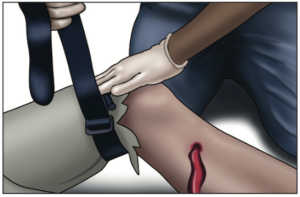Empowering Communities: The Vital Importance of Stop the Bleed Training
In a world where unforeseen tragedies can strike at any time, being prepared can mean the difference between life and death. This is why it is crucial for adults and adolescents alike to learn the techniques of Stop the Bleed. At ProAction, we offer this life-saving course to anyone who wishes to learn. With the skills obtained through Stop the Bleed training, individuals have the power to save lives, whether it’s their own or someone else’s. Today, we will delve into the significance of Stop the Bleed training and its immense impact on communities.
- Saving Lives Through Empowerment: Stop the Bleed training equips individuals with the knowledge and skills needed to take immediate action during emergencies involving severe bleeding. Such knowledge empowers them to become first responders in critical situations, potentially saving lives before professional medical help arrives. By learning how to properly use tourniquets and pack wounds, participants gain the confidence and ability to make a life-saving difference.
- Reflecting on the Tragedy of August 3rd: For the people of El Paso, the tragic events of August 3rd serve as a stark reminder that tragedy can strike unexpectedly. It highlights the need for communities to be prepared for unforeseen emergencies. “The tragedy of August 3rd, where so many innocent people died and were injured reminds us that this type of tragedy can happen anywhere and at any time, so it is better to be prepared. Stop the Bleed training is vital in a mass shooting” said Michelle Luevano, Director of Education for ProAction Emergency Services Institute.
- Effectiveness of Stop the Bleed Techniques: The techniques taught in Stop the Bleed training are simple yet incredibly effective. Acting quickly and properly is crucial when responding to severe bleeding. By applying tourniquets and packing wounds correctly, bleeding can be stopped or slowed down until professional medical help arrives. These life-saving actions can mean the difference between survival and tragic loss of life.
- A Program with a Noble Purpose: Stop the Bleed is a program that was initiated by the federal government after the tragic events at Sandy Hook Elementary. The techniques employed are drawn from the experiences of U.S. military members in combat situations in Afghanistan and Iraq. The ultimate goal of this initiative is clear and noble: to save lives. By disseminating these essential skills to the public, communities become better equipped to respond to emergencies and protect one another.
The significance of Stop the Bleed training cannot be overstated. In a world where unforeseen tragedies can strike without warning, being prepared is essential. This training equips individuals with the necessary skills to act as first responders during emergencies involving severe bleeding. The ability to stop or slow down bleeding until professional medical help arrives can be the key to saving lives. As communities come together to embrace the Stop the Bleed initiative, they unite in a shared mission of empowerment and protection. At ProAction, we are proud to offer this life-saving training, ensuring that our community is prepared to respond effectively and confidently when it matters most. Together, we can make a difference and create safer, more resilient communities.
Learn more about our Stop the Bleed training initiative by visiting: https://www.pro-action.org/stop-the-bleed or call 915-532-2771.


